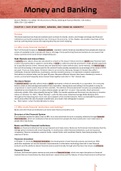Money and Banking
Source: Mishkin, F.S. (2022). The Economics of Money, Banking & Financial Markets. 13th edition,
ISBN: 978-1-292-40948-1
CHAPTER 1: WHY STUDY MONEY, BANKING, AND FINANCIAL MARKETS?
Preview
This book examines how financial markets (such as those for bonds, stocks, and foreign exchange) and financial
institutions work and by exploring the role of money in the economy. In this chapter, we provide a road map of this
book by outlining these issues and exploring why they are worth studying.
1.1 Why study financial markets?
Part 2 of this book focuses on financial markets—markets in which funds are transferred from people who have an
excess of available funds to people who have a shortage. Poorly performing financial markets are one reason that
many countries in the world remain desperately poor.
Debt Markets and Interest Rates
A security (also called a financial instrument) is a claim on the issuer’s future income or assets (any financial claim
or piece of property that is subject to ownership). A bond is a debt security that promises to make periodic payments
for a specified period of time. Interest rates are determined in debt markets (also: bond markets). An interest rate is
the cost of borrowing or the price paid for the rental of funds (usually expressed as a percentage of the rental of $100
per year). There are many types of interest rates in our economy. Because changes in interest rates affect
individuals, financial institutions, businesses, and the overall economy, it is important to explain substantial
fluctuations in interest rates over the past 40 years. Because different interest rates have a tendency to move in
unison, economists frequently lump interest rates together and refer to “the” interest rate.
The Stock Market
A common stock (typically called simply a stock) represents a share of ownership in a corporation. It is a security
that is a claim on the earnings and assets of the corporation. Issuing stock and selling it to the public is a way for
corporations to raise funds to finance their activities. The attention the [stock]market receives can probably be best
explained by one simple fact: It is a place where people can get rich—or poor—very quickly. Stock prices are
extremely volatile. After rising steadily during the 1980s, the market experienced the worst one-day drop in its entire
history on October 19, 1987—“Black Monday”—with the Dow Jones Industrial Average (DJIA) falling by 22%.
Throughout the following years more rises and collapses of the market followed. These considerable fluctuations in
stock prices affect the size of people’s wealth and, as a result, their willingness to spend.
Bull market = when the [stock]market is rising
1.2 Why study financia l institutions and banking?
Banks and other financial institutions are what make financial markets work.
Structure of the Financial System
If an individual wanted to make a loan to IBM, he or she would lend to such a company indirectly through financial
intermediaries, which are institutions that borrow funds from people who have saved and in turn make loans to
people who need funds.
Banks and Other Financial Institutions
Banks are financial institutions that accept deposits and make loans. Banks are the financial intermediaries that the
average person interacts with most frequently. In recent years, other financial institutions, such as insurance
companies, finance companies, pension funds, mutual funds, and investment banks, have been growing at the
expense of banks.
Financial Innovation
In Chapter 11, we study financial innovation, the development of new financial products and services. With
particular emphasis on how the dramatic improvements in information technology have led to new financial
products and the ability to deliver financial services electronically through what has become known as e-finance.
Financial Crises
At times, the financial system seizes up and produces financial crises, which are major disruptions in financial
markets that are characterized by sharp declines in asset prices and the failures of many financial and nonfinancial
1





